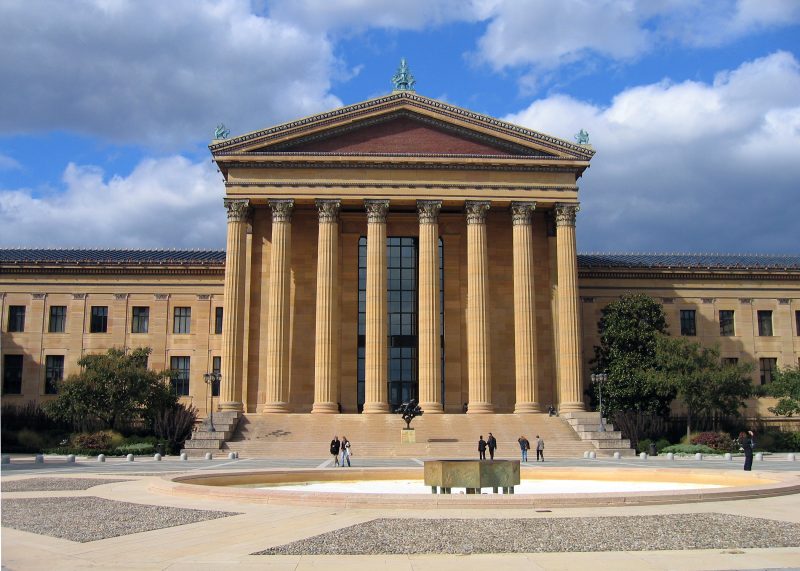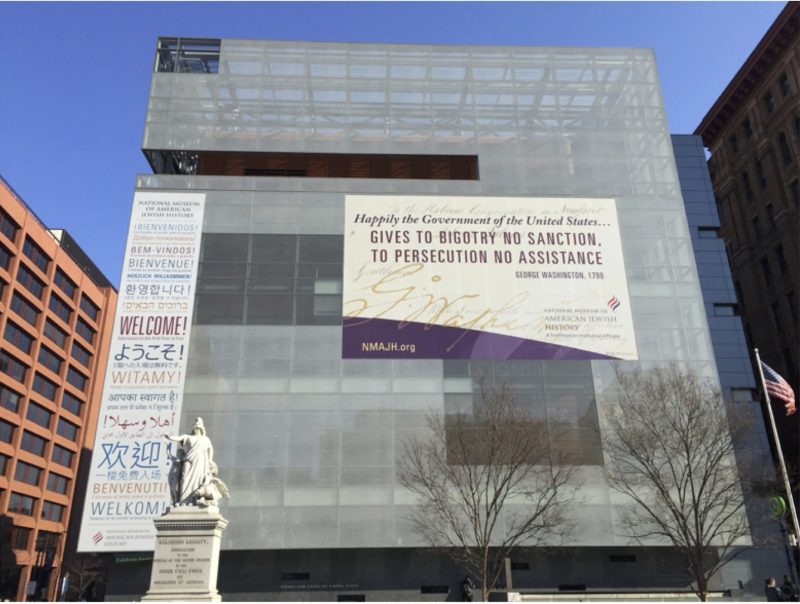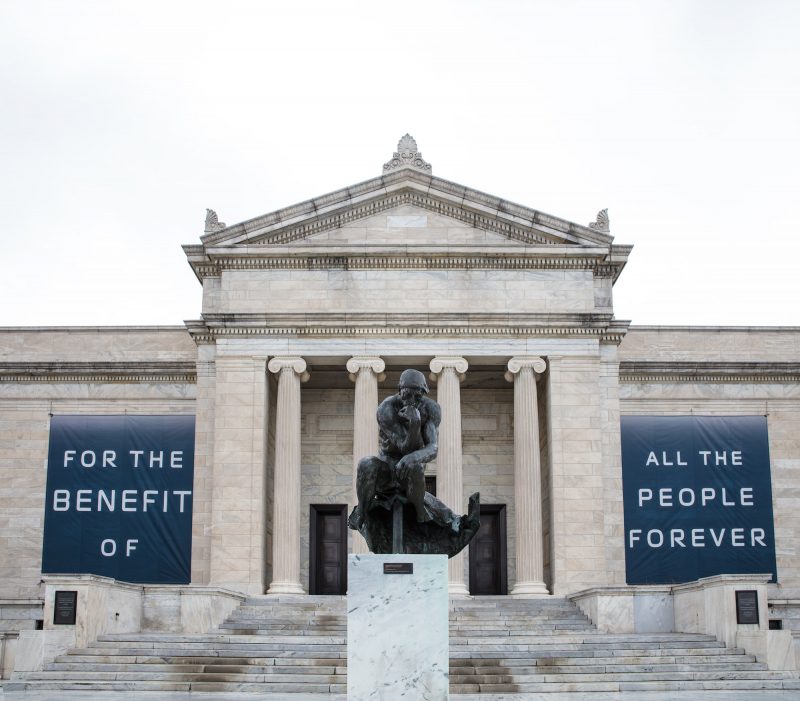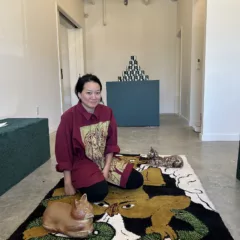In February, we published a letter from one of our readers, who complained that the leaders of our arts community, and the institutions they represent, have failed to speak out, and failed to formulate a coordinated response to the actions and the policies of the Trump administration which adversely affect, or threaten to adversely affect, their ability “to enlighten, to educate, and to enrich our lives” through art. The issues our reader identified in his letter were Trump’s immigration ban, state and federal funding cuts for the arts, sanctuary cities, and Trump’s appointment of Betsy DeVos as Secretary of Education.
Artblog gathers information

After receiving and publishing the letter, we reached out to many of the leaders of Philadelphia’s arts community, and the institutions they represent, and asked them whether they in fact were doing anything directly in response to the actions and policies of the new administration.
Our reach-out was targeted to the big institutions that we consider to have a leadership role in the city’s visual culture community. While we reached out to more, those who responded and with whom we spoke are representatives of the Philadelphia Museum of Art, the Institute for Contemporary Art, the Barnes Foundation, the Woodmere Art Museum, the American Jewish History Museum, Mural Arts Philadelphia, Temple Contemporary and the Greater Philadelphia Cultural Alliance (GPCA).
With the exception of the GPCA (the arts lobbying group), Temple Contemporary and ICA the short answer is this: none of the institutions we contacted have to date taken any direct, affirmative, public action in response to the policies or actions of the Trump administration. Behind the scenes, however, a number of the leaders we spoke with have been lobbying in favor of saving the NEH and NEA.
The political context
Here, it is important to note the political context elsewhere in the city. Philadelphia is a Sanctuary City, something re-affirmed after the presidential election by Mayor Jim Kenney. Philadelphia’s private, Ivy League school, the University of Pennsylvania, is a Sanctuary Campus, so declared by Amy Gutman, Penn’s President, on November 30, 2016.
In a historically progressive East Coast city, against which draconian measures have been threatened, we expected that the leaders of the arts community would feel compelled, and secure enough to speak up in public, or change their programming to reflect their resistance. No one has directly spoken out except Sadao of ICA, Blackson of Temple Contemporary and GPCA as we said above, and we are not aware that any of those institutions have either added to or modified their programming in response to current events, as, for example, the Museum of Modern Art did after Trump’s initial immigration ban, when the museum replaced various works in its permanent displays with works by artists from the countries subject to the ban, and scheduled screenings of films by directors subject to the ban.
Perhaps they are waiting for the dire measures to be enacted and not just threatened. We heard from some that they are worried about jumping the gun. These leaders are adopting a wait and see approach, suggesting that they might take action or speak out if state or federal budgets cuts which would affect them actually materialize, or, if tax reform is proposed that would reduce charitable giving, upon which they rely so heavily.
Perhaps they are letting the arts lobbying groups take charge. Most of the arts and cultural institutions in the area belong to the GPCA. Some also belong to the American Association of Museum Directors. Both those groups have made public statements about the proposed Trump funding cuts, and also about the immigration ban.
Here below, we will tell you, briefly, what we learned about what the institutions are doing or have done.
Workshops, panels, an article in a blog, and some new programs
The day before Trump’s inauguration, Amy R. Sadao, Director of the ICA, wrote an article in Hyperallergic about the decision many art institutions faced about whether to remain open or to close their doors on inauguration day. In the article, Sadao wrote:
“We work in recognition that political activism cannot and should not be disentangled from cultural institutions. I believe ICA’s program shows this clearly. . . .
Now is the time to double down for institutions and also to hold institutions accountable, especially those providing space for artists and publics, for the unknown, the unimagined, and the overlooked. In times of great conflict, every action and word has greater significance. This we take seriously, as is our responsibility to art, artists, and audience. ICA, alongside many contemporary museums and cultural organizations nationwide, will continue to make space for discourse and collectivity, for dissent and for the imaginary, for reflection and for action, on January 20th and beyond.”
Between the election and March, 2017, Temple Contemporary, an important gallery at Tyler School of Art, held panel discussions on a free press and on creating images; and a sign-making workshop initiated by faculty for the Women’s March protestors. They will do more in the fall with the start of the new school year, said Rob Blackson, gallery director. Blackson also shared his view about the importance for institutions to apply for NEA grants to demonstrate the need for the Endowment. He said his programming is focused on teaching active citizenship to the art students. Tyler School of Art has adopted teaching of active citizenship as part of its strategic plan.
The Kimmel Center and the Mural Arts Program recently kicked off a new series, “Art of the Protest,” featuring a panel discussion and sign-making workshops exploring how artists and members of the public express themselves in times of political change, which will encourage the local community “to make powerful and creative statements that ignite social change through support of local, national, and global causes.” The “Art of the Protest” is an expanded version of a project, “Signs Of Solidarity“, which was started by Conrad Benner, Aubrie Costello and Eric Preisendanz. Two workshops coming up are April 8th and May 1st.
The Da Vinci Art Alliance announced that in May it will open an exhibition, Crossing Boundaries, which will feature paintings and works on paper by artists born in other countries and celebrate diversity in the city, looking to art “as an antidote for high anxiety at this point in time . . .”
At Woodmere Art Museum, where Harry Philbrick is juror of the 2017 Annual juried show, the theme of this important open-call show is art responding to our fraught times.
Constraints in programming and institutional missions dictate status quo
Most told us about their constraints before they got to other matters. For starters, their programming is scheduled far in advance, and generally, they do not have the flexibility to respond to current events. Second, they are not activist organizations, and their missions do not include direct political advocacy or protest. Third, they mostly felt it was important for their institutions to raise relevant issues through their programming, but to do so in a nonpartisan way, welcoming all people and all points of view – essentially adopting a “marketplace of ideas” world view.
Current programming is already relevant
Over the years, we at Artblog have observed that Philadelphia’s major art institutions are becoming more diverse in including artists that ten years ago were not considered “museum worthy” or were just simply not considered.
In keeping with that observation, we heard the institutions tell us basically they believe they are already creating programs and exhibitions that are highly relevant to the issues raised by the new political order, perhaps even more relevant. Many of them, for example, promote programming and exhibitions which feature artists from disadvantaged or unrecognized groups, and from other countries, and their programming and exhibitions touch upon injustice, inequality, homelessness, violence, religion, race, class, gender, discrimination, and diversity, issues which many believe have become far more urgent since the election. As William Valerio, Woodmere’s Director and CEO, wrote in connection with a recent exhibition: “No matter where you may be on the political spectrum, the recent election prompts us to reflect deeply on all facets of multiculturalism in America, including race, sexual orientation and gender.”
Some programs have become more relevant

Perhaps the most visible example of programming that has become more relevant as a result of changes in the political environment is the National Museum of American Jewish History’s large banner pictured above, installed on the museum’s west wall facing Independence Mall, which highlights George Washington’s words: “Happily the Government of the United States . . . GIVES TO BIGOTRY NO SANCTION, TO PERSECUTION NO ASSISTANCE.” The museum installed this in December, 2016 (before the anti-immigration ban was proposed), and the banner is not directly in response to the election of Donald Trump, or to the actions and policies of his administration, but in response to its concerns about bigotry and hate speech in the country, which resonates with its core mission.
Another is Philadelphia Assembled, a collaborative effort, now almost five years in the making, between the Philadelphia Museum of Art and a team of individuals, collectives, and organizations which was initiated by Dutch artist Jeanne van Heeswijk at the invitation of the PMA. This project — the museum’s first-ever community project — is intended “to tell a story of active resistance and radical community building through the personal and collective narratives that make up Philadelphia’s changing urban fabric.” In a ground-breaking (for the PMA) fashion, most of the project has been taking place off-site in the community. But there will be a big museum component in the Perelman Building this fall, 2017, in which the communities and the artist will populate the museum with their ideas, stories and people.
At the Barnes Foundation, there is the current exhibition, Person of the Crowd: The Contemporary Art of Flânerie. “While that exhibition was planned well before the recent presidential election, it is even more timely now. The issues of social justice and the nature of democracy that the artists in Person of the Crowd are grappling with are the issues that we as a nation confront,” said Thom Collins, Director of the Barnes Foundation.
What are others doing
Whitney Museum – On inauguration day, the Whitney Museum sponsored a “Counter-inauguration speakout” by artists .
Davis Museum, Wellesley College – For a number of days after the travel ban was announced, the Davis Museum at Wellesley College shrouded or removed about 120 pieces, some 20% of its permanent collection, which were created or donated by immigrants to the United States. Davis called this initiative “Art-Less,” and noted that its action was being taken in support of a statement by the American Association of Museum Directors condemning Trump’s initial travel ban.
Metropolitan Museum – On February 22nd, Thomas Campbell, the director and chief executive of the Metropolitan Museum of Art, wrote an op-ed in the New York Times entitled “The Folly of Abolishing the N.E.A.” In the article, he eloquently outlined how every museum relies not only on financial support, but also on the advocacy of the NEA to strengthen communities through the arts.
Five Boston Museums – On February 24th, the directors of five prominent Boston museums – including MIT’s List Visual Arts Center, the Institute of Contemporary Art, the Harvard Art Museum, and the Museum of Fine Arts — published a letter defending the NEA, the NEH and the Corporation for Public Broadcasting. In the letter, they stated: “As directors of Boston’s art museums, we serve as stewards of the public trust. So, we are alarmed at reports that the National Endowment for the Arts is under threat of being abolished, along with the National Endowment for the Humanities and the Corporation for Public Broadcasting. Each of these entities champions art and culture in communities across America.”
Harvard University – On March 9th, Drew Gilpin Faust, Harvard’s president, wrote an op-ed in the New York Times – “Killing a Program That Brings History to Life,” in which she discussed the contributions of the NEH and the NEA to “our national soul,” and urged that the work of these organizations continue.

Cleveland Museum – On March 27th, the Cleveland Museum of Art affirmed its commitment to diversity and inclusion, announcing:
“In affirmation of its historic mission, on March 27 the museum will unfurl new banners bearing the words “for the benefit of all the people forever” on the façade of its 1916 building. In addition, both the museum’s website and new signage will emphasize the depth of its commitment to individual expression and the interconnectedness—and interdependency—of humankind.”
“The museum’s mission is as relevant and important today as it was over one hundred years ago,” Griswold [the museum’s director] noted. “It remains a place to explore history and creativity, a venue for the exchange of ideas, and an institution where neighbors can celebrate their differences and reflect on their shared humanity. In today’s increasingly fractured society, our mandate—to serve “all the people”—resonates more loudly and widely than ever before.”
Final thoughts
Sitting here today, it is difficult not to conclude that the arts, the humanities, even reason itself is under attack by the Trump administration. Perhaps ultimately the question is whether art, and the institutions of the art world, can find effective ways to counter the attack. We believe the proper response is leadership and resistance. It’s not enough to accept the status quo and wait for something more dire to happen. That is not a strategy but a giving up.
Philadelphia is a city with unprecedented amounts of public art, but we have no arts leader. Mayor Jim Kenney is terrific as a leader on social issues, but arts are not his “front burner” issues when he’s got children to educate, endemic poverty, and a large homeless problem and other social justice issues to confront daily.
The GPCA, our arts lobbying group, is great, but their most important impact is in the research they do with their non-profit members, arguing from data that the arts are an important economic engine in Philadelphia. They are not the leader of all of us, but maybe they could be.
We don’t know who the arts leader in Philadelphia is or should be. But we have long observed that the lack of arts leadership hurts us all. Without an arts leader, we have little-to-no arts in the Philadelphia public schools; we have little-to-no pan-university arts programming; we have no culture district for visual arts; we have little collaboration between arts institutions, who compete for funds from the same small pool of donors and foundations.
We don’t have the answer but we observe that we have great universities, great faculties, wonderful museums with enlightened directors. Surely someone, or a group, can assemble and take the gavel and call this community to order for a meeting. It’s overdue.








